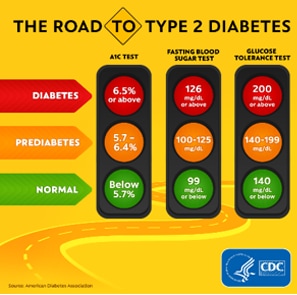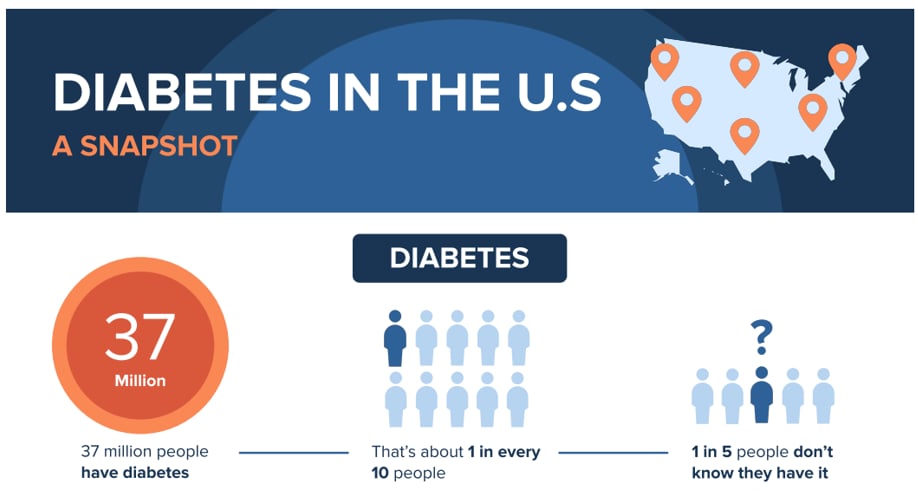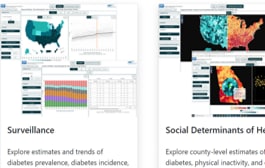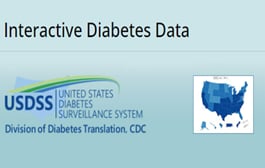Indicator Definitions – Diabetes

Diabetes is a chronic progressive disease that affects how our body turns food into energy. There are three main types of diabetes; type 1, type 2, and gestational diabetes (diabetes in women occurring while pregnant). Insulin, a pancreatic hormone, acts like a key to let the blood sugar into the body’s cells for use as energy. When a person has diabetes, the body either does not make enough insulin (type 1) or is unable to properly use insulin (type 2). When this occurs, the blood sugar (glucose) builds up in the blood and, over time, can lead to heart disease, stroke, blindness, kidney failure, amputations of the legs and feet and even premature death. Prediabetes is a condition in which blood sugar is higher than normal but not high enough to be classified as diabetes. In the United States, more than 133 million Americans were living with diabetes (37.3 million) or prediabetes (96 million) in 2019. For more information, visit Diabetes Basics | CDC.

Although we do not yet know how to prevent type 1 diabetes, we can prevent or delay type 2 diabetes by adopting healthier lifestyles through ways including but not limited to implementing healthier diets and staying active. The National Diabetes Prevention Program | CDC, a partnership of public and private organizations, makes it easier for people at risk for type 2 diabetes to participate in evidence-based lifestyle change programs to reduce their risk of diabetes.
Visit National Diabetes Prevention Program | CDC for more information.
Definition Details
| Population: | All adults |
| Numerator: | Adults who report being told by a doctor or other health professional that they have diabetes (other than diabetes during pregnancy for female respondents). |
| Denominator: | All adults |
| Measure: | Prevalence (crude and age-adjusted) |
| Time Period of Case Definition: | Lifetime |
| Summary: | In 2021 in the U.S., 8.5% of the U.S. adult population aged ≥ 18 years had diagnosed diabetes.1 For the same year, the overall median prevalence for all 50 states, District of Columbia, and territories was 11.1%.2 Substantial differences in diabetes prevalence exist by age, race, and ethnicity.1-3 The burden of diabetes in the U.S. has increased with the growing prevalence of obesity.3 Multiple long-term complications of diabetes can be prevented by managing blood glucose, blood lipids, and blood pressure regularly, eating healthy foods, being physically active, and by screening and early treatment for eye, foot, and kidney abnormalities.4 |
| Notes: | About one fourth of U.S. adults with diabetes are undiagnosed.5 As self-awareness of having diabetes is low, the prevalence of diabetes may be underestimated. |
| Data Source: | Behavioral Risk Factor Surveillance System (BRFSS) |
| Related Objectives or Recommendations: | Healthy People 2030 objective: D-01. Reduce the number of diabetes cases diagnosed yearly |
| Related CDI Topic Area: | None |
| Reference 1: | United States Diabetes Surveillance System, Division of Diabetes Translation, Centers for Disease Control and Prevention. United States Diabetes Surveillance System. https://gis.cdc.gov/grasp/diabetes/diabetesatlas.html |
| Reference 2: | Division of Population Health. BRFSS Prevalence & Trends Data: Explore BRFSS Data By Topic. Centers for Disease Control and Prevention. Accessed April 4, 2023. https://www.cdc.gov/brfss/brfssprevalence |
| Reference 3: | Geiss LS, Cowie CC. Type 2 diabetes and persons at high risk of diabetes. In: Narayan KMV, eds. Diabetes Public Health: From Data to Policy. Online ed. Oxford Academic; 2011:15–32. https://academic.oup.com/book/6900/chapter/151124452 |
| Reference 4: | National Center for Chronic Disease Prevention and Health Promotion. Prevent Diabetes Complications. Centers for Disease Control and Prevention. Accessed April 21, 2023. https://www.cdc.gov/diabetes/managing/problems.html |
| Reference 5: | Diabetes. National Diabetes Statistics Report: Prevalence of Both Diagnosed and Undiagnosed Diabetes. Centers for Disease Control and Prevention. Accessed April 4, 2023. https://www.cdc.gov/diabetes/data/statistics-report/diagnosed-undiagnosed-diabetes.html |
| Population: | Women who have had a recent live birth |
| Numerator: | Women who reported that a healthcare provider told them during their most recent pregnancy that they had gestational diabetes (diabetes that started during their most recent pregnancy). |
| Denominator: | Women who reported that a healthcare provider did or did not tell them during their most recent pregnancy that they had gestational diabetes (diabetes that started during their most recent pregnancy). |
| Measure: | Prevalence (crude) |
| Time Period of Case Definition: | During the pregnancy resulting in the most recent live birth |
| Summary: | Gestational diabetes is associated with pregnancy complications, including increased rates of large for gestational age birth, preeclampsia, and pre-term birth.1 Women with gestational diabetes have seven times higher risk of developing type 2 diabetes within 10 years of the gestational diabetes-affected pregnancy.2 Children born to mothers with gestational diabetes are also at increased risk of developing type 2 diabetes.3 Lifestyle interventions, such as the National Diabetes Prevention Program, have been shown to reduce risk of developing type 2 diabetes in high risk individuals.4 |
| Notes: | Because there are multiple recommendations and guidelines for gestational diabetes screening, diagnostic tests, and threshold values,5 changes in prevalence estimates reflect variation in clinical practice or true changes in the proportion of women with gestational diabetes.6 The numerator above reflects the question to be asked beginning with 2023 births (PRAMS Phase 9). Data from PRAMS Phase 8 (2016-2022 births) results from a slightly different question. The numerator for Phase 8 data is “Women who reported that during their most recent pregnancy they had gestational diabetes (diabetes that started during their most recent pregnancy).” |
| Data Source: | Pregnancy Risk Assessment Monitoring System (PRAMS) |
| Related Objectives or Recommendations: | Healthy People 2030 objective: MICH-6. Reduce maternal illness and complications due to pregnancy (complications during hospitalized labor and delivery). |
| Related CDI Topic Area: | Maternal Health |
| Reference 1: | Yang J, Cummings EA, O’Connell C, Jangaard K. Fetal and neonatal outcomes of diabetic pregnancies. Obstet Gynecol. 2006;108(3):644–650. doi:10.1097/01.AOG.0000231688.08263.47 |
| Reference 2: | Bellamy L, Casas JP, Hingorani AD, Williams D. Type 2 diabetes mellitus after gestational diabetes: a systematic review and meta-analysis. Lancet. 2009;373(9677):1773–1779. doi:10.1016/S0140-6736(09)60731-5 |
| Reference 3: | Dabelea D, Mayer-Davis EJ, Lamichhane AP, et al. Association of intrauterine exposure to maternal diabetes and obesity with type 2 diabetes in youth: the SEARCH Case-Control Study. Diabetes Care. 2008;31(7):1422–1426. doi:10.2337/dc07-2417 |
| Reference 4: | Diabetes Prevention Program Research Group. 10-year follow-up of diabetes incidence and weight loss in the Diabetes Prevention Program Outcomes Study. Lancet. 2009;374(9702):1677–1686. doi:10.1016/S0140-6736(09)61457-4 |
| Reference 5: | American College of Obstetricians and Gynecologists Committee on Practice Bulletins—Obstetrics. ACOG practice bulletin no. 190: gestational diabetes mellitus. Obstet Gynecol. 2018;131(2):e49–e64. doi:10.1097/AOG.0000000000002501 |
| Reference 6: | Deputy NP, Kim SY, Conrey EJ, Bullard KM. Prevalence and changes in preexisting diabetes and gestational diabetes among women who had a live birth — United States, 2012–2016. MMWR Morb Mortal Wkly Rep. 2018;67(43):1201–1207. doi:10.15585/mmwr.mm6743a2 |
| Population: | All adults |
| Numerator: | Death certificate records with International Classification of Diseases (ICD)-10 codes E10-E14 as an underlying or contributing cause of death among U.S. residents during a calendar year. |
| Denominator: | Midyear resident population. |
| Measure: | Mortality rate (crude and age-adjusted); number [cases per 100,000] |
| Time Period of Case Definition: | Calendar year |
| Summary: | During 2021, diabetes was the eighth leading cause of death in the United States, resulting in more than 103,000 deaths.1 Diabetes was nearly three times as likely to be listed as a contributing cause of death than as the underlying cause of death in 2021.2 Multiple long-term complications of diabetes can be prevented by managing blood glucose, blood lipids, and blood pressure regularly, eating healthy foods, being physically active, and by screening and early treatment for eye, foot, and kidney abnormalities.3 Ways to prevent complications include offering diabetes self-management education and support services along with provision of adequate and timely screening and medical care.3 |
| Notes: | About one fifth of U.S. adults with diabetes are undiagnosed.4 Diabetes is likely to be underreported as a cause of death, listed only on death certificates of about 40% of decedents who actually had diabetes.5 Causes of death and other variables listed on the death certificate might also be inaccurate or incomplete. |
| Data Source: | National Vital Statistics System (NVSS) |
| Related Objectives or Recommendations: | Healthy People 2030 objective: D-09. Reduce the rate of death from any cause in adults with diabetes |
| Related CDI Topic Area: | None |
| Reference 1: | CDC WONDER. Multiple Cause of Death, 2018-2021. Centers for Disease Control and Prevention. Accessed April 20, 2023. https://wonder.cdc.gov/mcd-icd10-expanded.html |
| Reference 2: | CDC WONDER. Multiple Cause of Death, 2018-2021. Centers for Disease Control and Prevention. Accessed April 20, 2023. https://wonder.cdc.gov/mcd-icd10-expanded.html |
| Reference 3: | National Center for Chronic Disease Prevention and Health Promotion. Prevent Diabetes Complications. Centers for Disease Control and Prevention. Accessed April 21, 2023. https://www.cdc.gov/diabetes/managing/problems.html |
| Reference 4: | Diabetes. National Diabetes Statistics Report: Prevalence of Both Diagnosed and Undiagnosed Diabetes. Centers for Disease Control and Prevention. Accessed April 4, 2023. https://www.cdc.gov/diabetes/data/statistics-report/diagnosed-undiagnosed-diabetes.html |
| Reference 5: | McEwen LN, Kim C, Haan M, et al. Diabetes reporting as a cause of death: results from the Translating Research Into Action for Diabetes (TRIAD) study. Diabetes Care. 2006;29(2):247–253. doi:10.2337/diacare.29.02.06.dc05-0998 |
| Reference 6: | McEwen LN, Kim C, Haan M, et al. Diabetes reporting as a cause of death: results from the Translating Research Into Action for Diabetes (TRIAD) study. Diabetes Care. 2006;29(2):247–253. doi:10.2337/diacare.29.02.06.dc05-0998 |
| Population: | All adults |
| Numerator: | Death certificate records with International Classification of Diseases (ICD)-10 codes (E10.1, E11.1, E12.1, E13.1, and E14.1) as an underlying or contributing cause of death among U.S. residents during a calendar year |
| Denominator: | Midyear resident population. |
| Measure: | Mortality rate (crude and age-adjusted); number [cases per 100,000] |
| Time Period of Case Definition: | Calendar year |
| Summary: | During 2021, diabetic ketoacidosis (DKA) was listed as the underlying cause of death for about 5,400 decedents.1 DKA is more frequent among people with type 1 diabetes than among people with type 2 diabetes. Although it is a life-threatening condition for people with diabetes, DKA is preventable through improved patient and caregiver education, effective diabetes self-management, proper medication adherence, and provision of adequate and timely medical care.2,3 |
| Notes: | The awareness of having the disease (diabetes) is higher among people with type 1 diabetes than among those with type 2 diabetes; however, about one fourth of U.S. adults with diabetes are undiagnosed.4 Although DKA is an acute event and expected to be listed more frequently as the underlying cause of death, diabetes is underreported as a cause of death and is listed only on death certificates of about 40% of decedents who actually had diabetes.5 Causes of death and other variables listed on the death certificate might also be inaccurate or incomplete. |
| Data Source: | National Vital Statistics System (NVSS) |
| Related Objectives or Recommendations: | Healthy People 2030 objective: D-09. Reduce the rate of death from any cause in adults with diabetes |
| Related CDI Topic Area: | None |
| Reference 1: | CDC WONDER. Underlying Cause of Death, 2018-2021. Centers for Disease Control and Prevention. Accessed April 20, 2023. https://wonder.cdc.gov/ucd-icd10-expanded.html |
| Reference 2: | Nyenwe EA, Kitabchi AE. Evidence-based management of hyperglycemic emergencies in diabetes mellitus. Diabetes Res Clin Pract. 2011;94(3):340–351. doi:10.1016/j.diabres.2011.09.012 |
| Reference 3: | Jefferies CA, Nakhla M, Derraik JGB, Gunn AJ, Daneman D, Cutfield WS. Preventing diabetic ketoacidosis. Pediatr Clin North Am. 2015;62(4):857–871 doi:10.1016/j.pcl.2015.04.002 |
| Reference 4: | Diabetes. National Diabetes Statistics Report: Prevalence of Both Diagnosed and Undiagnosed Diabetes. Centers for Disease Control and Prevention. Accessed April 4, 2023. https://www.cdc.gov/diabetes/data/statistics-report/diagnosed-undiagnosed-diabetes.html |
| Reference 5: | McEwen LN, Kim C, Haan M, et al. Diabetes reporting as a cause of death: results from the Translating Research Into Action for Diabetes (TRIAD) study. Diabetes Care. 2006;29(2):247–253. doi:10.2337/diacare.29.02.06.dc05-0998 |
| Reference 6: | McEwen LN, Kim C, Haan M, et al. Diabetes reporting as a cause of death: results from the Translating Research Into Action for Diabetes (TRIAD) study. Diabetes Care. 2006;29(2):247–253. doi:10.2337/diacare.29.02.06.dc05-0998 |






